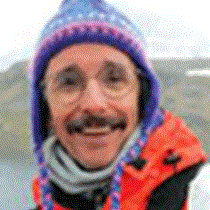Paulet Island
Unlike the Nordenskjold Expedition of 100 years ago – and the sundry misfortunes that befell the crew of the former sealing vessel, Antarctic, under the command of Carl Anton Larsen – we awoke this morning on a warm ship, downed a hot breakfast, and made landfall on Paulet Island, complete with full stomachs, digital cameras and bright red parkas. Blanketing the small volcanic island were 60,000 nesting Adelie penguins, most on eggs, a few on chicks. Others penguins commuted to and fro, those in white coming toward us, those in black going away, all busy with the business of raising another busy generation.
On the edge of the nesting colony stood the remains of Larsen’s hut, where he and his men over-wintered in 1903 after sea ice crushed their ship. The tide was out, so Captain Skog positioned the Endeavour a short distance off shore. Low tide also made for a brilliant display, as the receding waters had stranded icebergs like so many spilled blue diamonds, and Adelies stood atop them with patented nonchalance. We found a few nesting blue-eyed shags as well, and sleeping Weddell seals. Despite the chill conditions, many of us managed to get excellent photographs. No big surprise in this crowd.
Afternoon found us flanked by a flock of pintado petrels, a flying Jackson Pollock painting, as we proceeded south into the Erebus and Terror Gulf, in the Weddell Sea. Between James Ross, Seymour and Snow Hill islands (not far from where Otto Nordenskjold over-wintered in 1902 & 03) we nosed our bow into the fast ice and tested the idea of a walkabout. The ice was strong enough to support some unperturbed Adelies, but not people. So we turned north and put Snow Hill Island behind us, enamored with the story of Otto Nordenskjold and Carl Anton Larsen, but not so much that we wished to repeat their ordeal.
After dinner we landed on the Antarctic continent at Brown Bluff. Bitter wind, yes, but heavenly light. A pastel glow settled over Antarctic Sound and the distant snowy slopes of Joinville Island. We threaded our way past Adelie and gentoo penguins. Then upslope where the wind calmed and we stood speechless amid the musical chatter of pintado petrels, snowy petrels and Wilson storm petrels, all winging a feathery ballet off high volcanic cliffs.
Unlike the Nordenskjold Expedition of 100 years ago – and the sundry misfortunes that befell the crew of the former sealing vessel, Antarctic, under the command of Carl Anton Larsen – we awoke this morning on a warm ship, downed a hot breakfast, and made landfall on Paulet Island, complete with full stomachs, digital cameras and bright red parkas. Blanketing the small volcanic island were 60,000 nesting Adelie penguins, most on eggs, a few on chicks. Others penguins commuted to and fro, those in white coming toward us, those in black going away, all busy with the business of raising another busy generation.
On the edge of the nesting colony stood the remains of Larsen’s hut, where he and his men over-wintered in 1903 after sea ice crushed their ship. The tide was out, so Captain Skog positioned the Endeavour a short distance off shore. Low tide also made for a brilliant display, as the receding waters had stranded icebergs like so many spilled blue diamonds, and Adelies stood atop them with patented nonchalance. We found a few nesting blue-eyed shags as well, and sleeping Weddell seals. Despite the chill conditions, many of us managed to get excellent photographs. No big surprise in this crowd.
Afternoon found us flanked by a flock of pintado petrels, a flying Jackson Pollock painting, as we proceeded south into the Erebus and Terror Gulf, in the Weddell Sea. Between James Ross, Seymour and Snow Hill islands (not far from where Otto Nordenskjold over-wintered in 1902 & 03) we nosed our bow into the fast ice and tested the idea of a walkabout. The ice was strong enough to support some unperturbed Adelies, but not people. So we turned north and put Snow Hill Island behind us, enamored with the story of Otto Nordenskjold and Carl Anton Larsen, but not so much that we wished to repeat their ordeal.
After dinner we landed on the Antarctic continent at Brown Bluff. Bitter wind, yes, but heavenly light. A pastel glow settled over Antarctic Sound and the distant snowy slopes of Joinville Island. We threaded our way past Adelie and gentoo penguins. Then upslope where the wind calmed and we stood speechless amid the musical chatter of pintado petrels, snowy petrels and Wilson storm petrels, all winging a feathery ballet off high volcanic cliffs.




